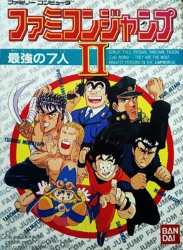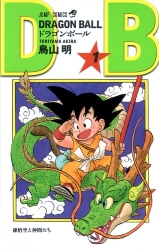Golden age (1980s–1990s)
Hiroki Goto was appointed chief editor in 1986 and remained in the position until 1993. His tenure saw significant increases in circulation, and the serialization of numerous popular series. When asked about the period, Goto stated: "We only tried to create manga that everybody can enjoy. There were no specific rules. Idol and tabloid magazines dominated in the Media & Entertainment industry at that time and we aimed to stand out from the crowd by using only manga as our weapon." Famicom Jump: Hero Retsuden, released in 1988 for the Family Computer was produced to commemorate the magazine's 20th anniversary. It was followed by a sequel: Famicom Jump II: Saikyō no Shichinin in 1991, also for the Family Computer. Shōnen Jump's circulation continued to increase year on year until 1995, peaking at 6.53 million copies. By 1998, circulation had dropped to 4.15 million copies, a decline in part ascribed to the conclusion of popular manga series Dragon Ball and Slam Dunk. The magazine peaked with a total readership of 18 million people in Japan during the early 1990s.

Famicom Jump
Famicom Jump: Hero Retsuden (ファミコンジャンプ 英雄列伝, Famikon Janpu Hīrō Retsuden, the subtitle translates to "Heroes History") is a 1989 role-playing video game for the Family Computer (Famicom/NES) published by Bandai. The game commemorates the 20th anniversary of Shueisha's manga anthology Weekly Shōnen Jump.
The game is set in a world that brings together many of the long-running titles, which include stories of the past and present at the time of their release, that had appeared in the magazine. The game consists of a main character wandering and encountering the many Jump heroes as they try to save the world from an alliance of many of the most powerful and evil of the Jump villains.
The game sold 1.1 million cartridges for the Famicom in Japan. It was the first title in the Jump video game series. It had a sequel, Famicom Jump II: Saikyō no Shichinin. Due to it being based on a magazine specifically localized for the Japanese market, the game was never released outside Japan.

Famicom Jump II: Saikyō no Shichinin
Famicom Jump II: Saikyō no Shichinin (ファミコンジャンプII 最強の7人, Famikon Janpu Tsū Saikyō no Shichinin) is an action role-playing game developed by Chunsoft and published by Bandai on December 2, 1991. The sequel to Famicom Jump: Hero Retsuden 『ファミコンジャンプ 英雄列伝』(published in 1989), the game features seven main characters from different Weekly Shōnen Jump manga serialized at the time. Only four of the 16 represented titles from the original are brought back, while the remaining three are new to the sequel. There would not be another crossover game until the release of Jump Super Stars and Jump Ultimate Stars.

Dragon Ball
Dragon Ball (Japanese: ドラゴンボール, Hepburn: Doragon Bōru) is a Japanese manga series written and illustrated by Akira Toriyama. Originally serialized in Shueisha's shōnen manga magazine Weekly Shōnen Jump from 1984 to 1995, the 519 individual chapters were collected in 42 tankōbon volumes. Dragon Ball was inspired by the Chinese novel Journey to the West and Hong Kong martial arts films. It initially had a comedy focus but later became an action-packed fighting series. The story follows the adventures of Son Goku, from childhood to adulthood, as he trains in martial arts and explores the world in search of the Dragon Balls, seven magical orbs which summon a wish-granting dragon when gathered. Along his journey, Goku makes several friends and battles villains, many of whom also seek the Dragon Balls.
The original manga was adapted into two anime series produced by Toei Animation: Dragon Ball and Dragon Ball Z, which were broadcast in Japan from 1986 to 1996; an anime sequel to Dragon Ball Z, Dragon Ball GT, was broadcast from 1996 to 1997. A media franchise has built up around the series; among the merchandise, there have been both animated and live-action films, collectible trading card games, action figures, collections of soundtracks, and numerous video games. The series was licensed for an English-language release in North America and the United Kingdom by Viz Media, and in Australia and New Zealand by Madman Entertainment. The companies initially split the manga into two parts, Dragon Ball and Dragon Ball Z to match the anime series but the most recent edition of the series was released under its original title.
Dragon Ball has become one of the most successful manga series of all time. Its initial serialization in Weekly Shōnen Jump was partly responsible for the magazine reaching its highest circulation of 6.53 million weekly sales. Its collected tankōbon volumes have over 160 million copies sold in Japan and 260 million sold worldwide, making it one of the best-selling manga series of all time. Reviewers have praised the manga for its comedy, fight scenes, and pacing, while recognizing a coming-of-age theme and its use of cultural references from Chinese mythology and Japanese folktales. Complaints from parents in the United States resulted in English-language releases being edited to remove nudity, racial stereotypes, and other content.
Also regarded as one of the most influential manga series, Dragon Ball has inspired numerous manga artists, including Eiichiro Oda (One Piece), Masashi Kishimoto (Naruto), and Tite Kubo (Bleach). A "midquel" series, titled Dragon Ball Super, has been published in V Jump since 2015. It is written by Toriyama and illustrated by Toyotarou.

Slam Dunk
Slam Dunk (stylized in all caps) is a Japanese sports manga series written and illustrated by Takehiko Inoue. It was serialized in Shueisha's shōnen manga magazine Weekly Shōnen Jump from October 1990 to June 1996, with the chapters collected into 31 tankōbon volumes. The story follows a basketball team from Shōhoku High School, located in the Shōnan area of Japan.
The manga was adapted into an anime television series by Toei Animation which aired from October 1993 to March 1996. The series has been broadcast worldwide, gaining popularity especially in Japan, Europe, and several other Asian countries. In December 2022, an anime feature film titled The First Slam Dunk was released in Japan.
Slam Dunk has 185 million copies in circulation, making it one of the best-selling manga series in history. In 1994, it received the 40th Shogakukan Manga Award for the shōnen category. In Japan, Slam Dunk has been regarded as one of the greatest sports manga series of all time and has been cited as a contributor in popularizing basketball among Japanese youth during the 1990s. In 2010, Inoue received special commendations from the Japan Basketball Association for helping popularize basketball in Japan.